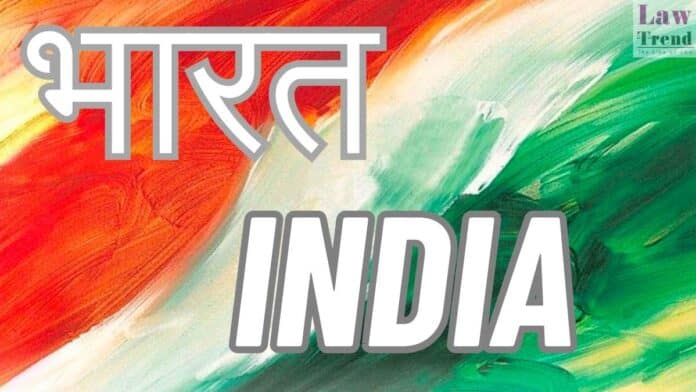Bharat Not “India”… this discussion has once again intensified after the G20 Invite from the President referred to as “President of Bharat”. In such a situation, it is very important for all of us to know and understand the journey behind the name of the country.
Our country has had different names since ancient times – like Jambudweep, Bharatkhand, Himvarsh, Ajnabh Varsh, Aryavarta, while the historians of their times gave names like Hind, Hindustan, Bharatvarsh, India, but among them ‘Bharat’ is the most used & popular.
Origin of Name “INDIA”
The name ‘India’ has a rich and interesting history, tracing its origins back to the ancient Indus valley civilization. Initially, there was no word like India or Indus; it all began with the word Sindhu. The Aryan people, who were Indo-Iranian in origin, referred to the great river Indus as the Sindhu, a Sanskrit word.
During the time period of 600 BCE to 300 BCE, Persian invaders arrived and started calling the river Sindhu as Hindu, which was the Persian equivalent. This marked the beginning of the name Hindu being associated with the river.
The Greek language gradually transformed the name from Hindu to Indos due to the loss of the /h/ sound in their dialects. Over time, this evolved into India as we know it today. Additionally, the Greeks also coined the term “Indian” to refer to the people living in the lower Indus basin.
The name India finds its roots in the ancient Indus valley civilization and the river Sindhu. The Persians and Greeks played a crucial role in giving the name its modern form. The names Sindhu, Hindu, Indos, and Bharat all hold significant historical and cultural importance in the rich tapestry of India’s identity.
Why the name “BHARAT”?
‘Bharat’ is also mentioned in Vishnu Purana.
There is a verse in Vishnu Purana: Uttaram Yatsamudrasya Himadreshchaiva Dakshinam. Varsham Tad Bharatam Naam Bharati Yatra Santati ( उत्तरं यत्समुद्रस्य: हिमाद्रेश्चैव दक्षिणम् । वर्षं तद् भारतं नाम: भारती यत्र संततिः ।।)
Meaning- The country that lies north of the ocean and south of the snowy mountains is called Bhāratam (India); there dwell the descendants of Bharata
Vishnu Purana says that when Rishabhdev left the forest, he gave succession to his eldest son Bharat due to which this country was named Bharatvarsha. Even in common parlance, we repeat this fact again and again that our entire nation lives from Kashmir to Kanyakumari. This is from one end of Bharat to the other.
Bharatkhand
The name Bharatkhand has been given in many other vedic texts including Vedas, Puranas, Mahabharata and Ramayana, which means part of Bharat, i.e. the land of Bharat.
Aryavarta
It is said that Aryans were the original inhabitants of Bharat. They reached here by sea routes and this country was settled by the Aryans. Because of this this country was called Aryavarta or the land of the Aryans.
Himvarsha
Bharat was earlier also called Himvarsha after the name of Himalayas. It is mentioned in Vayu Purana that long ago the name of Bharatvarsha was Himvarsha.
How the Constituent Assembly Chose?
The debate on Article 1 of the Indian Constitution in 1948 was marked by discussions on the name of the country. On November 17, 1948, the debate was scheduled to begin, but it was postponed on the suggestion of Govind Ballabh Pant.
It was on September 17, 1949, that Dr B R Ambedkar presented the final version of Article 1 to the House. This version included both ‘Bharat’ and ‘India’ as the names of the country. However, there were several members who expressed their disagreement with the use of ‘India’, as they believed it represented the country’s colonial past.
One member, Seth Govind Das from Jabalpur, favored placing ‘Bharat’ above ‘India’. Many members also demanded that it should be clarified that ‘India’ was a substitute for ‘Bharat’ in the English language. Das argued that “our country has been named ‘India that is Bharat’. It is a matter of gratification that the name Bharat has been adopted, but the way in which this has been put there has not given us full satisfaction. ‘India that is Bharat’ is a strange name.” He suggested using the words “Bharat known as India also in foreign countries” instead.
Shri Algu Rai Shastri of United Province said:
“It is, Sir, a matter of deep sorrow and deep regret for me that we in this country did not rise above the slave mentality and we did not say frankly what would be the name of our country. I think, Sir, there is no single country of the world which has such a clumsy name as we have given to our land that is ‘India, that is Bharat.’ The fact, Sir, is it is no name at all and we have failed very badly in giving it a proper name. My feeling is, Sir, that having a beautiful type of its own this Constitution has lost much of its sweet flavour on account of this short-coming on account of the absence of the name of Ram and would not be acceptable to many Hanumans.”
Also Read
Khandubhai K. Desai said:
“India has, no doubt, recovered herself; we have got our ancient India now. As regards the name of the country the term India that is Bharat” has been laid down in the Constitution and some of my friends objected to this term. As for me, I have no serious objection to it. It is a fact that we cannot live in isolation from the rest of the world; We have centuries old connections with England and the rest of the world. The world will always know us by the name of India. But so far as we are concerned, in our hearts and souls our country shall always remain as Bharat. So the term India and Bharat have been bracketed in order to meet the need of our countrymen as well as of the outsiders. The world will call us as India and we ourselves will call us as Bharat. Thus there will be blending of the East and the West.”
Hari Vishnu Kamath used the example of the Irish Constitution to support his argument that ‘India’ was merely a translation of ‘Bharat’. He referred to the Irish Constitution of 1937, which stated that “The name of the State is Eire, or, in the English language, Ireland”. Kamath proposed that India should follow a similar approach.
Hargovind Pant, representing the hill districts of the United Provinces, emphasized that the people of Northern India strongly preferred the name ‘Bharatvarsha’ and nothing else. Pant criticized the attachment some members had towards the name ‘India’ and its association with foreign rule. He believed that clinging to the name ‘India’ would imply that they were not ashamed of the insulting word imposed on them by alien rulers.
While Das referred to ancient texts like the Vishnu Purana and Brahma Purana that mentioned ‘Bharat’, others mentioned the seventh-century Chinese traveler Hiuen Tsang who referred to the country as Bharat.
Das argued that naming the country ‘Bharat’ would not hinder its progress. He believed that the name should reflect the history and culture of the nation. He also mentioned a pamphlet that aimed to prove that ‘India’ was more ancient than ‘Bharat’, which he disagreed with.
Kamath suggested ‘Bharat’, ‘Bharatvarsha’, or ‘Bharatbhumi’ as possible names derived from scriptures. He highlighted that historians and philologists had different opinions on the origin of the name ‘Bharat’.
Throughout the debate, Dr Ambedkar repeatedly stated that the question of the name Bharat was not opposed by members. He reminded the House that they were only discussing whether ‘Bharat’ should come after ‘India’. Ambedkar believed that the focus should be on the work that needed to be done rather than dwelling on the civilizational debate.
In the end, the motion for the name of the country was adopted, signifying the acceptance of incorporating both ‘Bharat’ and ‘India’ in Article 1 of the Indian Constitution.
What the Supreme Court Said?
In June 2020 a case came before the Supreme Court through a public interest litigation (PIL) which sought to change the official name of India to Bharat. The Bench of then Chief Justice of India SA Bobde and Justices AS Bopanna and Hrishikesh Roy questioned the necessity of such petitions when the Constitution already acknowledged India as Bharat.
While closing the case, the Bench ruled that the petition should be treated as a representation and be considered by the appropriate Ministries. This decision mirrored a similar PIL in 2014, when the apex court allowed the petitioner to make a representation to the appropriate authorities.
Following the Supreme Court’s ruling, the petitioner, Niranjan Bhatwal, sent a representation along with a copy of his plea to the Prime Minister of India, requesting appropriate action. However, the government declined the request and notified Bhatwal of their decision.
Bhatwal persisted and returned to the Supreme Court in 2015 with his plea. Unfortunately, this time his petition was dismissed. The Court concluded that they did not deem the case suitable for their interference under Article 32 of the Constitution and consequently dismissed the writ petition.
Author:
Rajat Rajan Singh
Editor-in Chief at Law Trend
Advocate at Allahabad High Court, Lucknow
Email-rajatrajansingh@gmail.com




